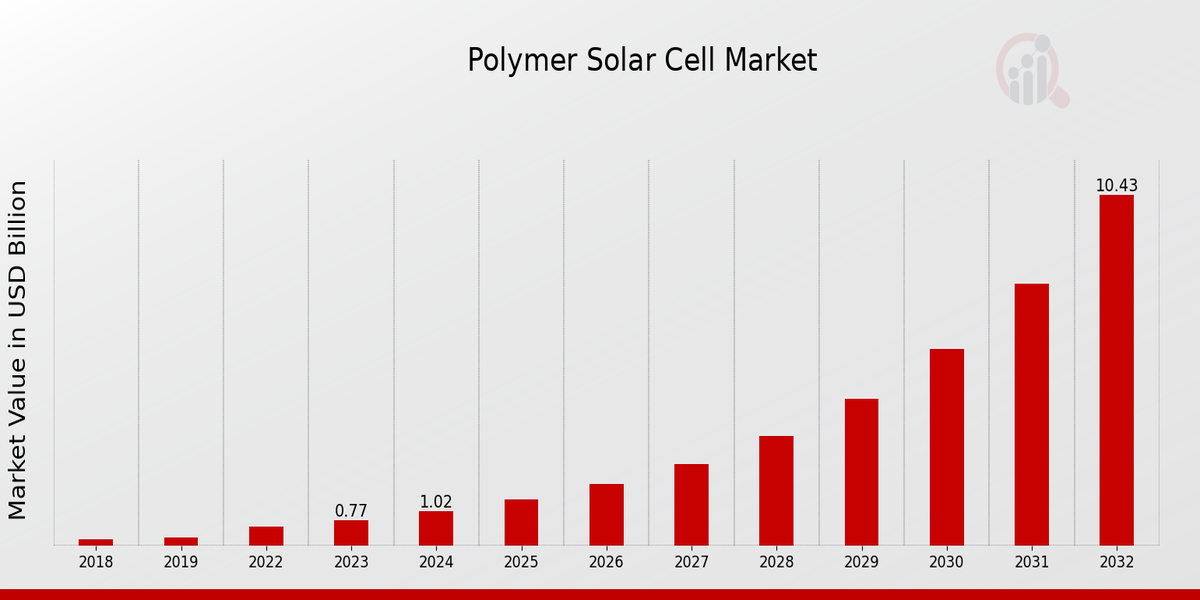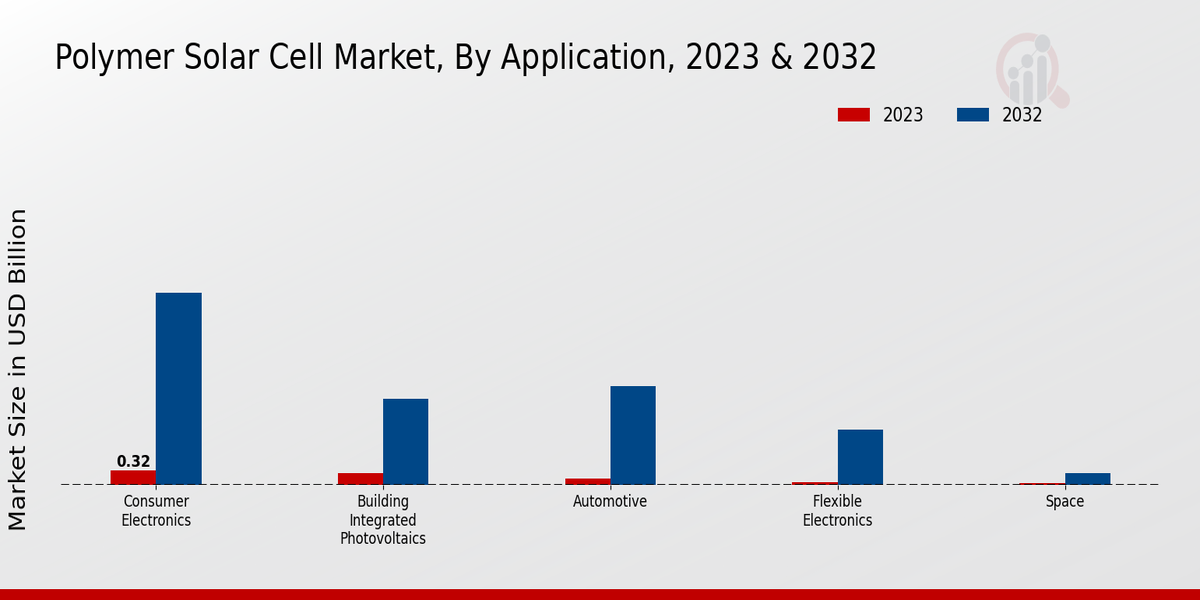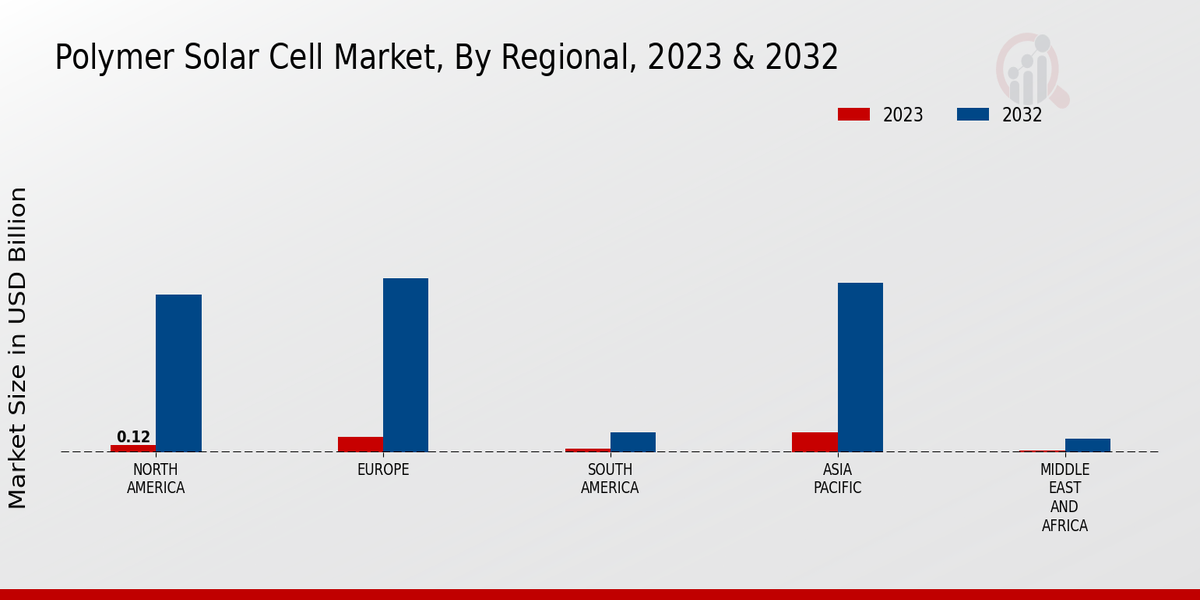Global Polymer Solar Cell Market Overview
The Polymer Solar Cell Market Size was estimated at 1.36(USD Billion) in 2024. The Polymer Solar Cell Industry is expected to grow from 1.82(USD Billion) in 2025 to 24.77(USD Billion) by 2034. The Polymer Solar Cell Market CAGR (growth rate) is expected to be around 33.70% during the forecast period (2025 - 2034).
Key Polymer Solar Cell Market Trends Highlighted
Key market drivers include rising demand for renewable energy sources, increasing concerns over environmental sustainability, and government incentives promoting the adoption of solar technologies.
Opportunities for growth lie in the development of new materials and technologies that enhance efficiency and reduce costs, as well as the expansion of applications in various industries such as consumer electronics and building-integrated photovoltaics. Recent trends indicate a shift towards ultra-thin, lightweight, and flexible polymer solar cells, enabling integration into diverse surfaces and enabling new product designs.
Additionally, advancements in tandem and multi-junction cell architectures are driving performance improvements, further expanding the potential applications of polymer solar cells in high-power generation systems.

Source: Primary Research, Secondary Research, MRFR Database and Analyst Review
Polymer Solar Cell Market Drivers
Rising Demand for Renewable Energy Sources
The growing concerns over climate change and the depletion of fossil fuels have led to a surge in demand for renewable energy sources. Polymer solar cells, with their ability to convert sunlight into electricity, are seen as a promising alternative to traditional energy sources. Their lightweight, flexibility, and low cost of production make them suitable for a wide range of applications, including portable devices, building-integrated photovoltaics (BIPV), and large-scale solar farms.As governments and industries worldwide set ambitious targets for renewable energy adoption, the Global Polymer Solar Cell Market Industry is poised for significant growth in the coming years.
Technological Advancements and Efficiency Improvements
Ongoing research and development efforts have resulted in significant advancements in the efficiency and performance of polymer solar cells. New materials and device architectures have enabled the conversion of a larger portion of the solar spectrum into electricity, leading to improved power output. Additionally, advancements in encapsulation and manufacturing techniques have enhanced the durability and stability of polymer solar cells, making them more suitable for outdoor applications.These technological breakthroughs are expected to drive the adoption of polymer solar cells in various industries, contributing to the growth of the Global Polymer Solar Cell Market Industry.
Government Incentives and Support
Governments worldwide are implementing supportive policies and incentives to promote the adoption of renewable energy technologies, including polymer solar cells. These incentives may include tax credits, subsidies, and feed-in tariffs that encourage businesses and individuals to invest in solar energy systems. Favorable regulatory frameworks, such as net metering schemes, also support the deployment of polymer solar cells by allowing excess electricity generated to be sold back to the grid.Government initiatives and financial assistance play a crucial role in stimulating the growth of the Global Polymer Solar Cell Market Industry and accelerating the transition towards a more sustainable energy future.
Polymer Solar Cell Market Segment Insights:
Polymer Solar Cell Market Application Insights
The Global Polymer Solar Cell Market segmentation by Application comprises Consumer Electronics, Building Integrated Photovoltaics (BIPV), Automotive, Flexible Electronics, and Space.
Consumer Electronics: In 2023, the segment held a dominant market share due to the rising demand for lightweight, flexible, and portable electronic devices such as smartphones, tablets, and wearable technology. The integration of polymer solar cells into these devices offers advantages like improved aesthetics, enhanced durability, and the ability to harvest energy from ambient light, leading to increased adoption.Building Integrated Photovoltaics (BIPV): The BIPV segment is projected to witness significant growth owing to the growing emphasis on sustainable building practices and the need for energy-efficient solutions. Polymer solar cells can be seamlessly integrated into building facades, windows, and roofing systems, enabling the generation of renewable energy while maintaining the architectural integrity of structures.
Automotive: The Automotive segment is anticipated to gain traction due to the increasing adoption of electric and hybrid vehicles. Polymer solar cells offer the potential to power auxiliary systems such as sensors, displays, and lighting, reducing the reliance on traditional batteries and enhancing vehicle efficiency.Flexible Electronics: The Flexible Electronics segment is poised for substantial growth driven by the rising popularity of wearable and foldable devices. Polymer solar cells, with their flexibility and lightweight nature, can be easily incorporated into these devices, enabling the development of innovative applications in healthcare, fashion, and entertainment.
Space: The Space segment is expected to experience steady growth due to the increasing demand for lightweight and efficient power sources in space missions. Polymer solar cells offer advantages such as high specific power, flexibility, and radiation tolerance, making them suitable for powering satellites, rovers, and other spacecraft.Overall, the Global Polymer Solar Cell Market by Application is characterized by strong growth prospects and diverse opportunities across various industries. The increasing demand for renewable energy solutions, coupled with the unique advantages of polymer solar cells, is driving the expansion of this market segment.

Source: Primary Research, Secondary Research, MRFR Database and Analyst Review
Polymer Solar Cell Market Polymer Type Insights
The Polymer Type segment is a crucial aspect of the Global Polymer Solar Cell Market segmentation. The market is segmented into three main types: Conjugated Polymers, Semi-Crystalline Polymers, and Non-Crystalline Polymers. Conjugated Polymers held the largest market share in 2023, accounting for around 60% of the Global Polymer Solar Cell Market revenue. This is due to their high efficiency and low cost. Semi-Crystalline Polymers are expected to grow at the highest CAGR during the forecast period, owing to their improved stability and performance.This growth is attributed to the increasing demand for renewable energy sources and the declining cost of polymer solar cells.
Polymer Solar Cell Market End-User Insights
The Global Polymer Solar Cell Market is segmented into various end-user segments, including residential, commercial, industrial, and government. The residential segment is expected to account for the largest share of the market in 2023, driven by the increasing demand for energy-efficient and sustainable solutions in residential buildings. The commercial segment is also expected to witness significant growth, with increasing adoption of solar energy in commercial properties. The industrial segment is expected to have a moderate growth rate, with demand for polymer solar cells in manufacturing and production facilities.The government segment is expected to have a steady growth rate, supported by government initiatives and policies promoting renewable energy.
Polymer Solar Cell Market Efficiency Range Insights
The efficiency range segment is an important aspect of the Global Polymer Solar Cell Market segmentation. It categorizes the market based on the power conversion efficiency of the polymer solar cells. The efficiency range is a crucial factor that determines the performance and cost-effectiveness of polymer solar cells. The 0-5% efficiency range segment is expected to account for a significant share of the market in the coming years. This segment includes polymer solar cells with low power conversion efficiency, making them suitable for low-power applications such as wearable devices and sensors.The 5-10% efficiency range segment is also expected to witness significant growth due to its potential for use in building-integrated photovoltaics (BIPV) and other architectural applications. The 10-15% efficiency range segment is a rapidly growing segment, driven by the increasing demand for high-performance polymer solar cells. These cells offer a balance between efficiency and cost, making them suitable for a wide range of applications, including portable electronics and grid-connected solar systems. The 15-20% efficiency range segment represents the highest efficiency polymer solar cells currently available in the market.These cells are primarily used in research and development applications, with the potential for future commercialization in high-power applications such as solar farms and electric vehicles. The Global Polymer Solar Cell Market is expected to grow significantly in the coming years, driven by increasing demand for renewable energy sources and technological advancements. The efficiency range segment plays a crucial role in driving market growth, as it determines the performance and cost-effectiveness of polymer solar cells. By understanding the dynamics of this segment, market players can identify opportunities and develop strategies to cater to the evolving needs of customers.
Polymer Solar Cell Market Regional Insights
The Global Polymer Solar Cell Market is segmented into North America, Europe, APAC, South America, and MEA. Among these regions, Europe is expected to be a crucial market during the forecast period. The growth in this region is driven by the increasing adoption of polymer solar cells in building-integrated photovoltaic (BIPV) applications.North America is expected to have a market size of USD 0.12 billion in 2023 and is expected to grow at a CAGR of 30.5% during the forecast period. The growth in this region is attributed to the rising demand for polymer solar cells in portable and flexible electronics applications. South America and MEA are expected to have a market size of USD 0.05 billion and USD 0.03 billion, respectively, in 2023. The growth in these regions is expected to be driven by the increasing investments in renewable energy projects.

Source: Primary Research, Secondary Research, MRFR Database and Analyst Review
Polymer Solar Cell Market Key Players And Competitive Insights:
Major players in the Polymer Solar Cell Market industry are constantly striving to develop innovative products and solutions to meet the evolving demands of the market. They are also focusing on strategic partnerships and collaborations to expand their market reach and gain a competitive edge. Leading Polymer Solar Cell Market players are investing heavily in research and development to enhance the efficiency, stability, and cost-effectiveness of their products. The Polymer Solar Cell Market development is driven by the growing demand for renewable energy sources and the increasing adoption of solar energy.One of the leading companies in the Polymer Solar Cell Market is Heliatek. The company is a pioneer in the development and production of organic photovoltaic (OPV) solar cells. Heliatek's OPV solar cells are lightweight, flexible, and can be easily integrated into various applications, making them suitable for a wide range of markets. The company has a strong focus on innovation and has developed a number of proprietary technologies that give it a competitive advantage in the market.A key competitor of Heliatek in the Polymer Solar Cell Market is Oxford Photovoltaics. The company is a leading manufacturer of OPV solar cells and has a strong presence in the commercial and industrial markets. Oxford Photovoltaics' OPV solar cells are known for their high efficiency and durability, making them a popular choice for a variety of applications. The company is also committed to sustainability and has a number of initiatives in place to reduce its environmental impact.
Key Companies in the Polymer Solar Cell Market Include:
Polymer Solar Cell Market Industry Developments
The market growth is attributed to increasing demand for renewable energy sources, rising environmental concerns, and government initiatives to promote solar energy adoption. Recent advancements in polymer solar cell technology, such as improved efficiency and reduced production costs, are further driving market expansion. Key industry participants are focusing on strategic partnerships, product innovations, and capacity expansions to capture market share. Notable developments include collaborations between research institutions and industrial players to develop novel materials and device architectures, as well as investments in pilot-scale production facilities to scale up manufacturing capabilities.
Polymer Solar Cell Market Segmentation Insights
| Report Attribute/Metric |
Details |
| Market Size 2024 |
1.36(USD Billion) |
| Market Size 2025 |
1.82(USD Billion) |
| Market Size 2034 |
24.77(USD Billion) |
| Compound Annual Growth Rate (CAGR) |
33.70% (2025 - 2034) |
| Report Coverage |
Revenue Forecast, Competitive Landscape, Growth Factors, and Trends |
| Base Year |
2024 |
| Market Forecast Period |
2025 - 2034 |
| Historical Data |
2020 - 2024 |
| Market Forecast Units |
USD Billion |
| Key Companies Profiled |
Trony Solar Ltd., Novaled AG, Plextronics, Inc., SunLink Corporation, Ynvisible Interactive Inc., Heliatek GmbH, Solarmer Energy Inc., Hanergy Holding Group, UbiQD, Inc., TanneryTech, Inc., Konarka Technologies, Inc., Varta Microbattery GmbH |
| Segments Covered |
Application, Polymer Type, End-User, Efficiency Range, Regional |
| Key Market Opportunities |
Lightweight Flexible Solar Cells, Low-Cost Inkjet Printing Production Self-Powered IoT Devices, Wearable Electronics Portable Charging Solutions |
| Key Market Dynamics |
Technological advancements, cost reductions, renewable energy demand, increasing investments emerging applications |
| Countries Covered |
North America, Europe, APAC, South America, MEA |
Frequently Asked Questions (FAQ) :
The Global Polymer Solar Cell Market is expected to reach a valuation of 24.77 USD Billion by 2034.
The Global Polymer Solar Cell Market is anticipated to exhibit a CAGR of 33.70% from 2025 to 2034.
Major applications include portable and flexible electronics, building-integrated photovoltaics (BIPV), and automotive applications.
Some prominent players in the market are Heliatek, Konarka Technologies, Inc., and Solarmer Energy, Inc.
High production costs and limited efficiency compared to traditional silicon-based solar cells pose challenges to market growth.
Advancements in technology, increasing demand for renewable energy sources, and government incentives drive market expansion.
Growing demand for portable and flexible electronics fuels the adoption of polymer solar cells due to their lightweight and flexibility.
Miniaturization, transparent solar cells, and the integration of energy storage systems are shaping market trends.
Ongoing research and development efforts focus on improving the power conversion efficiency of polymer solar cells.

















